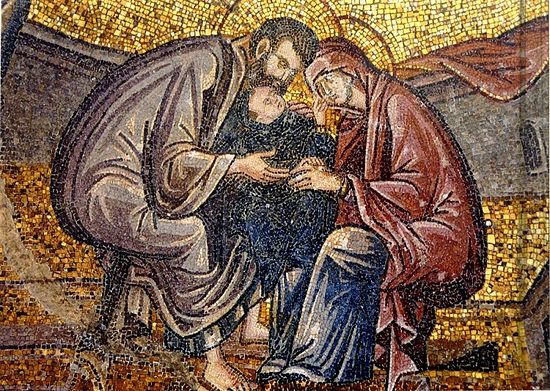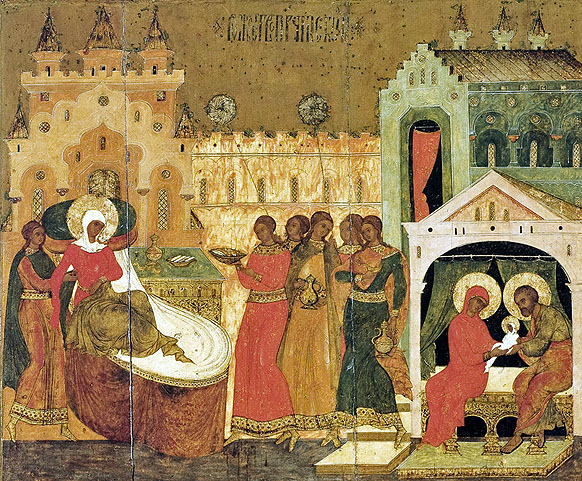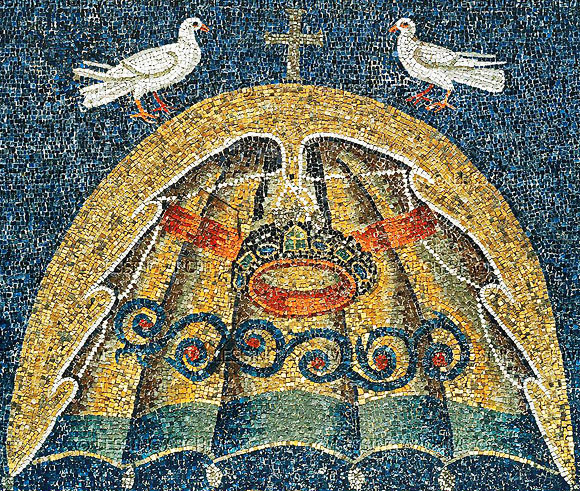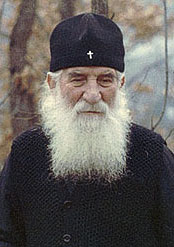The birth of any person is a mysterious event. This is not just another event for the registrar; a new being is come into the world, filled with inextricable mystery. In fact: what will this newborn person bring to the world, and what will life give him? This is why parents and relatives greet each new child with awe and trembling. This is why the first cry of a new being resounds forever in his parents’ hearts. How will this person newly come into the world live his life? Will he be talented and capable, will he enrich mankind’s common treasury of gifts, or will his days be grey and mediocre, will he depart unnoticed after tasting sorrows and sadness on this earth, all memory of him lost? The more notable a person is in life, the more solemnly do people celebrate his birthday.
The Sunday before Christ's Nativity: St. John Chrysostom on the Genealogy of Christ
Greetings!
For the past forty days we are called by our Church to prepare for Christ's Nativity. On the Sunday before Christmas, the Genealogy of Christ from the first chapter of St. Matthew is read as one of many preparations for us before Christ's Holy Birth. Below are excerpts from the commentary of St. John Chrysostom on this section of the Holy Gospel.
The Sunday before Christ's Nativity: St. John Chrysostom on the Genealogy of Christ
“The book of the generation of Jesus Christ, the Son of David, the Son of Abraham.”
How did Stephen See Transcendent Glory? Who Laid Bare Heaven’s Gates for Him?
St. Gregory of Nyssa
December 26th is the Feast of St Stephen, the First Martyr.
Yesterday the Lord of the universe welcomed us whereas today it is the imitator [Stephen] of the Lord.
[...] One assumed human nature on our behalf while the other shed it for his Lord.
One accepted the cave of this life for us, and the other left it for him.
THE PRESENTATION OF THE MOTHER OF GOD
The Presentation or Entry (είσοδος) of the Mother of God in the Temple (November 21st) does not belong to the most ancient festivals of the Church. None the less, it must be earlier than the end of the VIIth century, since St. Andrew of Crete had known it at Jerusalem at this epoch. It seems that it was introduced at Constantinople a century later, under the Patriarch St. Tarasius. It was to be adopted in the West only under Pope Gregory XI, who had it celebrated for the first time at Avignon in 1374.
On the Birth of Our Most Holy Lady, the Mother of God
Today, the Virgin Mother is born from a barren mother and the palace is bedecked for the coming of the Lord Christ. Today, the bonds of sterility are broken and the gates of the Virgin are barred. Because, as the barren womb was dead for the purposes of child-bearing and yet, against all hope, brought forth a wonderful fruit, so, by the same token, incorruptible virginity is pledged and the miracle of birth-giving is heralded with works obvious to all. Because child-bearing without the intervention of a man is a supernatural miracle, as is the preservation of virginity after birth. Another person who overcomes the laws of nature is the barren woman who conceives in her old age and gives birth.
The beginning of the Church Year
Fr. Lev Gillet
The Byzantine liturgical year begins on 1 September. A brief inspection of the texts read at the services for this day indicates the internal attitude which the Church wishes to inculcate in us at the beginning of the year.
At Vespers for 1 September, which, in Byzantine style is celebrated on the evening of 31 August [because that is when the day begins according to this reckoning, not 12 o’clock midnight], there are three readings from the Old Testament. The first is from the Prophet Isaiah (61, 1-9: ‘The Spirit of the Lord is upon me because he as anointed me… they are a seed blessed of God’). This is the passage read by the Lord- and applied to Himself- in the synagogue in Nazareth, as we hear in the liturgy on the morning of 1 September. There are some words of Isaiah’s which don’t come into the passage quoted by the Lord, but which are nevertheless worthy of particular attention: ‘And they shall build on ancient wastelands, they shall resurrect what was formerly made desolate and restore cities abandoned for generations’ (61, 4). There’s a message of hope here for those who consciously bring to the threshold of the new year a soul full of desolation and barrenness: our spiritual desert can be salvaged in the year which is beginning. The prophet also informs us what God will do for those who are afflicted: He will give them ‘glory instead of ashes, the unguent of joy to those who mourn, the garment of glory instead of the spirit of sloth’.
The Beheading of Saint John, the Glorious Prophet, Forerunner and Baptist of the Lord
Saint Justin Popovich
Today is a little Great Friday, a second Great Friday. Today the greatest man of those born of women, John, the Holy Forerunner and Baptist of the Lord, is slain. On Great Friday, God, was murdered, God was crucified. At today’s holy and great feast, the greatest of all men was put to death. The choice of the expression ‘the greatest’ is not mine. What are my praises of the great and glorious Forerunner of the Lord, when the Lord Himself praised him more than anyone among men, more than any of the apostles, the angels, the prophets, the righteous, the wise? The Lord declared: ‘among those born of women there has arisen no one greater than John the Baptist’ (Мatt. 11, 11). In all Creation, there exists no greater praise.
Jesus’ Walk on the Sea
‘And when He had sent the multitudes away, He went up into the mountain apart to pray: and when evening came, He was there alone. But the ship was now in the midst of the sea, tossed by waves:for the wind was contrary’.
Why did He go up into the mountain? To teach us that solitude and retirement are good, when we are to pray to God. With this in mind, you see, He continually withdraws into the wilderness, and often spends the whole night in prayer there, teaching us to seek earnestly the quietness in our prayers that the time and place affords. For the wilderness is the mother of quiet; it is a calm harbour, delivering us from all turbulence.
The Sign of the Cross in the Old Testament
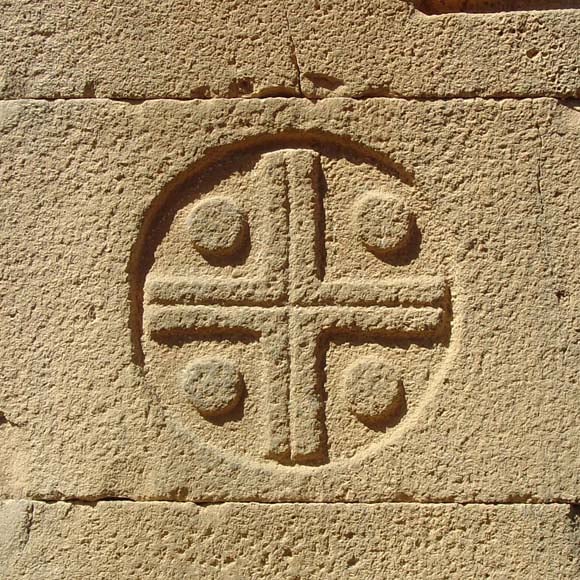 In his first epistle to the Corinthians Saint Paul mentions that the “Jews seek a sign” (I Cor. 1, 22), that they wanted a supernatural sign, such as the resurrection of the dead, cure of the possessed, and so on that would allow them to believe in the teaching concerning the Cross. So they looked for some supernatural sign, ignoring and overlooking the signs and wonders that God had already shown them in the past, every time they were in danger. Of course, the sign they were seeking could hardly have been anything other than that of the Cross, which, on the one hand, was prefigured throughout the Old Testament and, on the other, was permanently present and saved the people of Christ from destruction and annihilation.
In his first epistle to the Corinthians Saint Paul mentions that the “Jews seek a sign” (I Cor. 1, 22), that they wanted a supernatural sign, such as the resurrection of the dead, cure of the possessed, and so on that would allow them to believe in the teaching concerning the Cross. So they looked for some supernatural sign, ignoring and overlooking the signs and wonders that God had already shown them in the past, every time they were in danger. Of course, the sign they were seeking could hardly have been anything other than that of the Cross, which, on the one hand, was prefigured throughout the Old Testament and, on the other, was permanently present and saved the people of Christ from destruction and annihilation.
Subscribe to:
Posts (Atom)

